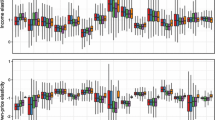Abstract
When a general equilibrium model is solved, there areoften a large number of exogenous shocks. The changein each endogenous variable obviously depends on thesedifferent shocks.We point out a natural way of decomposing thechanges (or percentage changes) in the endogenousvariables as sums of the contributions made by thechange in each exogenous variable. The change in anyendogenous variable is exactly equal to the sum of thecontributions to this change attributed to each of theexogenous variables.The contribution of a group of exogenous variablesto the change (or percentage change) in any endogenousvariable is defined to be the sum of the contributionsof the individual exogenous variables in the group. Ifall the exogenous variables are partitioned intoseveral groups that are mutually exclusive andexhaustive, the change (or percentage change) in anyendogenous variable is just the sum of thecontributions made by these groups.We introduce, and motivate, these decompositions inthe context of a published GTAP application in which10 regions remove import tariffs and non-tariffbarriers to imports. We use the methods given in thispaper to report numerical values for the contributionsto the welfare gains of various regions due to tariffreductions by particular regions or groups of regionsin this simulation. We show how the values obtainedvia the decomposition are related to the estimates inthe published study of the contributions to welfaregain due to certain groups of tariff reductions.We describe a practical procedure for calculatingthe contributions of individual exogenous variables orgroups of exogenous variables to the changes (or thepercentage changes) in all of the endogenousvariables. This procedure, which applies to a widerange of general equilibrium models, is now automatedin GEMPACK in a version that will be made publiclyavailable in the future.The contributions that make up the decompositionare defined as integrals. As such, they depend on thepath by which the exogenous values move from theirpre-simulation to post-simulation values. We proposeone natural path, namely a straight line between thesetwo points. Along this path, the ordinary rate ofchange is constant for each variable.
Similar content being viewed by others
References
Apostol, T.M. (1957). Mathematical Analysis: A Modern Approach to Advanced Calculus. Addison-Wesley, Reading.
Atkinson, K.E. (1989). An Introduction to Numerical Analysis. Wiley, New York, second edition.
Chenery, H., Robinson, S. and Syrquin, M. (1986). Industrialization and Growth: A Comparative Study. Oxford University Press (especially pp. 133-135 in Chapter 5, The Methodology of Multisector Comparative Analysis, pp. 121-147).
Dervis, K., de Melo, J. and Robinson, S. (1982). General Equilibrium Models for Development Policy. The World Bank (especially pp. 337-339).
Dixon, P.B. and Rimmer, M.T. (1998) Forecasting and policy analysis with a dynamic CGE model of Australia. CoPS/IMPACT Working Paper Number OP-90 (available electronically from URL http://www.monash.edu.au/policy/ELECPAPR/op-90.htm).
Fane, G. (1971). Import substitution and export expansion: their measurement and an example of their application. Pakistan Development Review, 11, 1-17.
Fane, G. (1973). Consistent measures of import substitution. Oxford Economic Papers, 25, 251-261.
Harrison, W.J. and Pearson, K.R. (1996). Computing solutions for large general equilibrium models using GEMPACK. Computational Economics, 9, 83-127.
Harrison, W.J., Horridge, J.M. and Pearson, K.R. (1999). Decomposing simulations results with respect to exogenous shocks. CoPS/IMPACT Preliminary Working Paper Number IP-73. Monash University.
Hertel, T.W. (ed.) (1997). Global Trade Analysis: Modeling and Applications. Cambridge University Press.
Press, W.H., Flannery, B.P., Teukolsky, S.A. and Vetterling, W.T. (1986). Numerical Recipes: The Art of Scientific Computing. Cambridge University Press.
Vogt, A. (1978). Divisia indices on different paths. In W. Eichhorn, R. Henn, O. Opitz and R.W. Shephard (eds), Theory and Application of Economic Indices. Physica-Verlag, Wurzburg, 297-305.
Author information
Authors and Affiliations
Rights and permissions
About this article
Cite this article
Harrison, W.J., Horridge, J.M. & Pearson, K. Decomposing Simulation Results with Respect to Exogenous Shocks. Computational Economics 15, 227–249 (2000). https://doi.org/10.1023/A:1008739609685
Issue Date:
DOI: https://doi.org/10.1023/A:1008739609685




